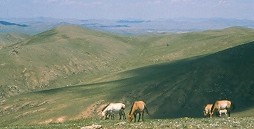 The Przewalski horse is a dweller of the steppe. Until some 15,000 years ago this immense belt of grasslands stretched away from Manchuria in the East to the Iberian Peninsula in the West. The 30,000-year-old cave-drawings found in France and Spain depict a small stout wild horse with Przewalski-like features.
The Przewalski horse is a dweller of the steppe. Until some 15,000 years ago this immense belt of grasslands stretched away from Manchuria in the East to the Iberian Peninsula in the West. The 30,000-year-old cave-drawings found in France and Spain depict a small stout wild horse with Przewalski-like features.
Once millions of large herbivores, such as auerochs (urus), wild sheep, goats, horses and many others flocked the vast grasslands. However, the rise of agriculture and husbandry caused the wild horses to retreat into ever more inhospitable areas until the species finally became extinct from the wild in the desert of Southwest Mongolia in the 1960s.
Another species of wild horse, the tarpan, which succeeded to survive in Poland and in southern Russia, had already become extinct in 1879. The ancestor of our domestic cattle faced their doom at an earlier stage. Around the beginning of the thirteenth century the auerochs had become a rarity in western Europe. How long it succeeded to hold out in Central Asia is unknown. However, around 1600 the auerochs disappeared definitively. The vanishing steppe dragged its inhabitants along in its demise.
Unlike Europe, Mongolia has still its comparatively undisturbed steppes. Although, even here threatened in their existence the wild goats (ibex), gazelles and the mighty Argali sheep still roam the vast Mongolian grasslands. Thanks to the return of the Przewalski horses and the protective measures that are being implemented, Hustai National Park and its steppe can rejoice in the rebirth of its original and unique ecosystem.
